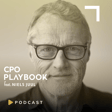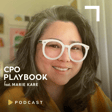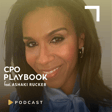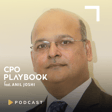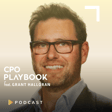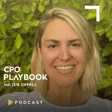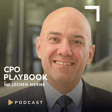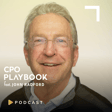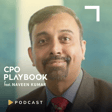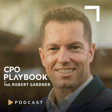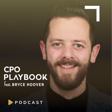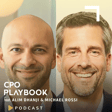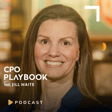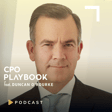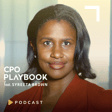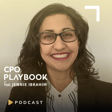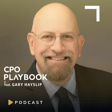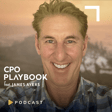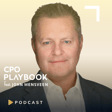Introduction to CPO Playbook Podcast
00:00:01
Speaker
I'm Felicia Shakiba, and this is CPO Playbook, where we solve a business challenge in every episode.
Influence of Company Values on Workforce
00:00:10
Speaker
Company values are the principles and beliefs that drive the behavior and decision-making within the organization. They set the standards for how employees interact with each other, customers, and other stakeholders. Values are not just motivational words. They are the foundation of the company culture and play a crucial role in shaping the organizational identity. The importance of mission, vision, and values cannot be overstated. They provide a framework for decision-making, guide strategic planning, help to create a cohesive and motivated workforce, and communicate what you stand for to customers and other outside stakeholders.
00:00:51
Speaker
When clearly communicated and embraced, these elements foster a strong sense of purpose and direction, leading to increased employee engagement, customer loyalty, and ultimately improved business performance.
Revamping Potbelly's Mission and Values
00:01:05
Speaker
Today, I'm joined by Pat Walsh, the Chief People Officer of the well-known restaurant chain based in Chicago, Potbelly Sandwich Works. Pat, what triggered the need to revamp Potbelly's mission, vision, and values? I would break it down into two things. One is we were really focused on a new chapter of growth for the organization. And so that was turning the page to a new outlook for us that we felt like needed to be matched by a really strong foundation of mission, vision, and values that was going to guide our path for what that growth was going to deliver on.
00:01:42
Speaker
The second piece and really complimentary to that is we had a pretty new leadership team. Our CEO had been here a few years, but really all of the rest of us had come in at some portion following that. And we had finally completed the leadership team with my my hire and one other individual. And it was about we needed a shared vision and a shared focus that we could really get behind as a leadership team that would allow us to really drive the culture and the results of the organization. So I think those two things are probably two sides of the same coin. But we knew that it was really time to lay that foundation for that next step for us as an organization. So the growth of the organization, that was a shift in where the organization is going. And then this new leadership team comes in and we need to all be aligned. And so that refresh was prompted.
00:02:30
Speaker
Yes, it was really that we made our decision to become a growth organization and popularly had grown since since 1977 had grown to over 400 units. But our aspirations had us and we say this in our public statements, we want to be a 2000 unit organization really across the company. And that's a different mindset and a more ambitious mindset. that I think the brand had for some time. And so with that, I feel like we'll talk about this later. I'm sure of admission, vision, and values really is where everything starts. And we didn't have one that had been recrafted or reshaped within the last really three to four years. Coming out of COVID was certainly challenging.
00:03:04
Speaker
was challenging on the industry as a whole, of course, on many industries, but food service and restaurants in particular. And so a lot of the company was focused on emerging from COVID successfully and stronger. And then this was basically taking that step to our next phase of growth, which we were looking to achieve.
Defining New Mission, Vision, and Values
00:03:19
Speaker
Great. So let's talk about the process. What was that process that you used to engage the leadership team in defining these new statements? First off, we had a really aligned leadership team that came in and said, we recognize there's a gap here. And so when I think about any process like this, I think about it as a bit of a change management process because you're starting at one point and you've got to look at the other point. So there are a lot of great change management models out there. I really like the idea of a five step Harvard change management model that I've leaned down throughout my career.
00:03:52
Speaker
And one of the things that we started with is they talk about preparing the organization, creating the case. And that was largely done for us. I think that was there was already an underpinning that said, we need a fresh focus and fresh start here. And we decided as a leadership team, we were going to get in a room, the old fashioned, hey, look, we have to work together to craft what this is going to look like for the organization. but also integrate different perspectives from our teams and from veterans who've been with the organization for some time, as well as maybe folks who are newer to the organization and bring a set of diverse perspectives to how we were going to approach that. So that was the first thing I did was really lift some support of our leadership team, in particular, our CMO, David Daniels. He and I ah really co-led this. I think he brought a really great perspective on the brand perspective and what was true to us.
00:04:35
Speaker
And I was focused on bringing what's our underpinning of our culture of listening to her that I did as a fairly new chief people officer, really feeling like I had a good pulse of some of the perspectives of what the organization was feeling. And so you mentioned this five-step process. What does that outline look like? Yeah, absolutely. I think preparing the case for the organization, understanding that crafting a vision for what you want to achieve would be step two, implementing what you want to achieve once you have that vision and that outline together, and then ultimately embedding the changes so you've got a sustainable approach and sustainable foundation for the future. So that's the way we approached it, and I'm happy to elaborate a little bit on some of those steps, if that would be helpful.
00:05:18
Speaker
We can maybe dig into what part of those steps allows you to identify the exercises that really helped surface those key themes and priorities, and assuming that is where you might have started. Yeah, absolutely. I think when we decided we needed to craft this vision and put this together, I was fortunate to have a really strong leadership team and a really well tightly knit leadership team. But like in any environment, you're going to have different perspectives. You have to be open to a healthy tension and an open dialogue.
00:05:51
Speaker
And so we were preparing for an onsite face-to-face leadership team meeting. We're a fully remote-based culture and organization, so we scheduled those sessions and they're really critical for us to make the most of that FaceTime together. One of the things I was thinking about is how do we make sure we can make the best use of this time and get everyone's perspective out without taking three days to debate a few sentences of a mission vision of values. And one of the things we did is I actually had folks fill out information ahead of time, put their perspective down on a survey that I did. And I was able to compile that information results and share that back with them as part of our prelude to the session. And I think what came out of that was we immediately recognized that we all had really similar sentiments and aspirations for what we wanted to achieve. We may have had a slightly different way of talking about them or wording it.
00:06:38
Speaker
But ultimately, we were aligned on the core principles and values of what we felt like that should be. And I think that saved us, accelerated the process, if you will, because rather than have to start by just openly debating conceptual ideas, we really were able to coalesce around, hey, we have a lot of common here. It's really going to be about refining it to the point that we feel great about taking this to the organization. I love that you talk about healthy debate because I think that sometimes in organizations it's hard to get there. So I have more questions, but I want to start with what does healthy debate look like?
00:07:14
Speaker
Honestly, this is, in my mind, this is one of the most important roles that certainly any leader can play, but I think as HR leaders and as the stewards of the culture of the organization and as the people that are connected to the people of the organization, this is one of the key roles we play, is to create an environment where you have a safe space for healthy debate. And one of the things that we've done in this environment, right, we didn't have our fresh set of mission, vision, and values yet. And a lot of us were newer as a leadership team. What we did was we simply talked openly about some ground rules and expectations for this exercise. And some of those things were essentially you have to check your ego at the door. We have to be ensure that we are collaborative, we're all focused on the same outcome, and we can't take anything personally around feedback, thoughts, perspectives. And so we agreed to that. The other thing is, and I won't go through all the ground rules we talked about, but just being open-minded, we had a lot in common which helped establish that. I think that survey that I talked about earlier,
00:08:09
Speaker
I think that helps get people on the same page and realize that again, we might have slight differences in how we're thinking about this, but ultimately we're shooting for the same goal. But I think in those sessions, I felt it was incumbent upon me to make sure that we were drawing out people's true feedback, but also sometimes interjecting and and ensuring that we were staying true to those principles when things may have started to elevate a little bit. And so it was something I was very caught as a note throughout the process.
00:08:37
Speaker
Logistically speaking, how long did this process take? Where did you go? Was it an offsite? Who was invited to this meeting? What were the types of different exercises? Was it one
Alignment Through Feedback and Sessions
00:08:47
Speaker
exercise? Just trying to wrap my head around the logistics of the technique that you're using. It was about three different face-to-face sessions with our senior leadership team. So there's eight of us, including our CEO that are our C-suite executives. And we did that across several off-site live sessions and a couple of virtual follow-ups that involved some things. Like I said, the survey that I mentioned, a couple of follow-ups with recapping some of the work that we did. So that was really the group that shaped it. In between there, we were intentional about, because that is that can be a bit of an insular group. You want to think about, hey, we're the the most senior leaders of the organization. but
00:09:21
Speaker
We also want to make sure that we're connected to other inputs across the organization. So we were intentional about ensuring that we each spent time within our teams, getting feedback, socializing some of the concepts in between these sessions we were talking about and getting some perspective to say, here's what we're thinking. Are we on the right track with this? Because I think anytime you're doing something like refresh or a new mission, vision, and values, you've got to think about this organization has a history. There are people that have been here for a long time that may be very attached to something about the history. And in our case, they had a right to be proud of what probably started as ah an antique shop that sold sandwiches in Chicago in 1977 and grew to 400 plus unit location. A lot of folks have been here since the 90s when it became more of the business we know it as today.
00:10:03
Speaker
And so you got to think about if I'm going to chart a new course, I don't want to alienate folks that are passionate about the brand and that have contributed a lot to our success. But at the same time, we want to chart that new course and engage people going forward. And so you're walking this line of we want it to feel fresh, but familiar. And so I think that was our key focus and I'm confident where we landed that we achieved that. How did you achieve consensus among these differing yet similar perspectives? Because at the end of the day, we can't have three different mission statements and vision statements and so forth. So when it came down to the decision, how did that work itself out?
00:10:45
Speaker
It's funny, I wish I had very magical type of input on this. I think it really, most of it came down to very old fashioned, we're going to write it on the board, where we're going to write it out, we're going to look at it, we're going to discuss it. And we're literally going to debate words. I mean, I remember standing up there and crossing out a word and writing a new word above it, right? We did that numerous times and as sometimes tedious as that could feel in the moment, you recognize that. words matter and word choices really matter and it's worth it to invest that time. So I think a lot of the consensus was looking at it and literally discussing and debating a word or two here or there. And there were a couple of situations where it just seemed reality the way organizations work.
00:11:23
Speaker
There were a couple of different perspectives that were all hovering around the same outcome. And a couple of times our CEO, Bob, said, I think that's where we're going to go with. And I think we did a great job, though, overall as a team. And sometimes we need that person to make the decision. And ultimately, we all landed in a place where everyone feels good about where we landed with the Popbelly way. Okay, so you found the right words, you made a decision, you did the entire process, everybody feels good. And now what do the new statements communicate about Potbelly culture and direction?
00:11:57
Speaker
Well, we're really excited about it. It's known as the Potbelly Way. When we look at it, we didn't try to reinvent the wheel. The concepts that are here, I think, are things that are really authentic to our organization. I think that's ultimately what's most important about any set of mission, vision, and values. And so I also think back to when a video that probably many of us have seen with Simon Sinek back in a number of years back where he talked about the why, how, what, of what you do. And to me, I think about mission, vision, and values really being that. So to me, our why
Potbelly's Core Values and Customer Service
00:12:25
Speaker
is our vision, which is to be the most loved sandwich brand in every neighborhood. And the why of that is we're aspiring to inspire emotional connection with our consumers, right? We want people to love who we are and what we do.
00:12:38
Speaker
We want, we talk about the category that we're in, what we provide. We're a sandwich brand. Certainly we have other things on the menu, but at our core, that's what we do. And we want to be in every neighborhood. We think of ourselves as a neighborhood shop. We want to have that feel and we want to grow, right? We're not in every neighborhood today, but we want to be and we aspire to be. And so we think that conveys, hey, this is why we exist and what we're trying to accomplish. Our mission is delight customers with great food and good vibes. That's what we do. That's what we aspire to do every day. Great food and good vibes has been a part of Potbelly for a long time. And it's simple. We kept it because we didn't do away with that. We kept that integrated because that means a lot to people. It speaks to delighting people who come through our doors, serving them food that they love, and creating a positive good vibes environment.
00:13:22
Speaker
And then the last couple of things, we've got eight values. Those were all very intentional there. And that's about how we're going to achieve what we achieve. And so the values individually are, again, very intuitive and things that I think felt like your typical person that we want to come and join popular or you want a customer to experience. are things that folks generally would all feel good about experiencing, things like community, belonging, teamwork, integrity, things that are not really debatable, but in combination are really powerful, particularly in the service
Embedding Values in Training and Reviews
00:13:52
Speaker
industry. And the very last piece that I'll mention, and this is outside mission, vision, and values, but this is a part of where we felt like we had to incorporate this is we have something in popularly we call sideways service, and it's we put it in our statement, in our visual,
00:14:07
Speaker
as how we distinguish ourselves with one-of-a-kind service from our brand. That is a legacy Potbelly thing. Again, feels like it has differentiated Potbelly over the years. It was passionate to a lot of people, and the sideways is an acronym. I won't go through all the letters because it's a lot of letters for customer service approach, but there's a story behind it that if you work for Potbelly, you understand, and it's something that's unique to us. So we incorporated it in there as well because we felt like it was really the heart of our customer service mantra. So I think what it ultimately, back to your question, what it says about us is we exist to bring great food to our customers. And ultimately, we have a really clear way that we're going to do that. That's going to help guide all of our decision making around what we do, how we operate, how we behave, and what we do as an organization.
00:14:52
Speaker
When we think about what we've created, mission, and vision, values, that's only the starting point, right? And I know that the work that I've done with organizations, it's like, how do you really allow the organization to live and breathe these values? And so what was your strategy or the steps that you took to introduce the new framework internally? Yeah, absolutely. So we wanted to communicate it really as one leadership team and really clearly as we were unveiling it. I think that's so important, by the way, and making sure that everybody's on the same page. and It's harder said than done. But yeah, that's a very key piece of that.
00:15:36
Speaker
Absolutely. No. And we were really excited. This was late last year when we were probably no October, November timeframe, we had a town hall, which we do every quarter after we release earnings. We want to get our folks together and talk about the business and talk about what we're doing. And it was prominently featured in that town hall, which I think is powerful because there are a lot of different communications that venues that you can use and that companies do use town halls are common venues, particularly to talk about the business and earnings growth and business health. I think when you can dedicate a big portion of a company-wide venue like that where the CEO is a featured speaker, that conveys a lot about the importance of what you're communicating. And and that was the case here. Bob Wright, our CEO, was a champion of this the whole way through, and he communicated it, talked about what it means to him, his expectations, and that was our launching point. From there, we've had, I would say we're still in the process of embedding this in the organization. It takes time. But some of the things that we are hard at work on is integrated it into our training materials. We train a lot of folks through down through our shops, to folks we bring in in corporate. It's being integrated into our training and leadership materials as we speak for our performance reviews. It was new this year. We didn't make it part of the rating per se, but we did include it in the performance review document at the end of last year where
00:16:47
Speaker
managers in their direct reports were having discussions about the values, about areas that where they showed up strongest, where they may could maybe show up a little bit more strongly. And we felt like that was a powerful step as well. The last piece we're working on is the recognition element. I think I'm a big believer in recognition. What you reinforce and recognize is what you tell people is important. or what people see as important and the behaviors that you get. and So we are working on a ah recognition program company-wide that builds on this, and even on an individual team level. Actually, on I have a team ah a town hall for my HR team tomorrow, and we're going to be unveiling values-based recognition program for h our HR team based on our potbelly way values at our meeting tomorrow. So a lot of work in progress, but something that we're incredibly excited to continue to drive forward.
00:17:36
Speaker
I love everything that you talked about because I feel like so a lot of times when you're creating these mission vision values, that is just the core and then the behaviors and the recognition that goes along with the performance and the manager training. I mean, those are big hitters on how to make this work and come alive and design and shape and adapt culture. What have you seen? so far that has made an impact. Obviously, it hasn't been very long, like you said. What are you seeing that's really showing up that you're getting good feedback on? I think certainly it is new and we're looking to continue to drive that forward. I will tell you a couple of things that come to mind. We made a decision that I think last year was in concert as we were thinking about the kind of organization we wanted to be and what this mission and vision values would define for us.
00:18:30
Speaker
And I'll go a little bit detailed here on, we recognize that we needed to hear more from our employee base, just on an ongoing basis, right? If we're going to live up to the values that we're saying are important here and being a great customer organization, we've got to be a great people organization. That comes from listening to feedback and getting feedback. And so we actually went out and we sourced a vendor partner. that would help us do that better. And we implemented a program that fits with that. We did that earlier this year. And I bring this specific example up because I've got a couple of pieces of feedback here that I wrote down because they were meaningful to me in thinking about what we'd be talking about today. We have an ongoing, a lot of companies do engagement surveys right once a year, or every other year or something like that. What we have, which I'm really proud about and excited about is something that touches folks throughout their life cycle.
00:19:15
Speaker
with the organization during their onboarding phase multiple times while they're ongoing, they get a quarterly pulse check, and yeah actually once they leave the organization, they get an exit survey check and we're able to really internalize all this information. And they can also provide us qualitative feedback. And so one of the things we ask them on that among multiple things is, are we living up to our values of the potbelly way? and how or why not. We've already gotten over 1,000 data points of feedback. We have about 5,000, a little over 5,000 employees. So we've been active on this since February. We've got over 1,000 data points. We learned about opportunity areas for sure around how we can be better measuring up to our standards.
00:19:50
Speaker
But you get some comments that I think help you recognize we are doing a lot of great things and that we can continue to accentuate. And if I could, I'd love to read just a couple of quick comments that actually came through this. So I've got two here. And this person, I'll protect, well, they're anonymous comments. So I won't be sharing any names. But this individual says, I've been with Potbelly for about three and a half years. I started out as an associate. I am now a catering coordinator. I was given the opportunity to move up. And for that, I am grateful. You also get a raise once a year with a good review. I'm blessed with a great GM and great coworkers. I plan on staying with Potbilly for many years. I'm very happy with my job. You read something like that and you think when we talk about achievement, one of our values, we talk about teamwork. Those are things that, hey, that's an example of living up to this.
00:20:31
Speaker
I have one other one, community and belonging is in here. And this actually one just came across this morning, my desk, which I was excited to see. And we asked if you would recommend Potbilly as a place to work. Why? And this person said, great team leadership, great team support with my career, but especially in-store. I have intellectual and developmental delay and my team is very, very good at helping me and making sure I'm part of the team and always checking in if I can better myself in my job.
Franchisee Integration into Cultural Framework
00:20:55
Speaker
and I think about if we can have that type of environment, which is consistent with our values in the potbelly way, that's just going to serve us tremendously well for not only just being a great place to work and a place where folks are welcome to come and be successful, but our customers are going to have a great experience when we have folks in that mindset as well.
00:21:12
Speaker
I agree completely that mindset and the way people feel about the business 100% translates into how the customers feel about the business and that community and belonging piece. I think a lot of people think obviously this is super important, but for those who are skeptical, I would say maybe move back a few more seconds and re-listen to what dad just said. Right? Because whoever that person is, providing excellent customer experience on the other end, because that's what they're committed to doing, because they're thankful.
00:21:44
Speaker
Absolutely. Yeah. and And we're putting this information, this data, obviously it's designed to protect anonymity, which we will always do, but putting this in the hands of our other leaders too. So it's not just me as an HR person who's looking at this or my team and looking at this. we We do see these things, but we're actually putting this in the hands of our operations leaders to say, what is your team saying on an ongoing basis? How is that? How are you doing? How are we doing as leaders, creating great environments within our shops that live up to our values? And so I think that's where I see this being a real difference maker for us. And I think here back to your original question, which is this is going to help us shape and amplify and accelerate how we are embedding those values and the the overall mission, vision values across the organization.
00:22:26
Speaker
One of the questions I have in seeing where Potbelly is going, I know that you're looking at franchisees and I always think about franchisees and worry about culture. What role are franchisees playing in adopting this new cultural book? Yeah, it's a great question. It's a unique and interesting space to be in the franchising business. I think it's a great business model for a lot of reasons, but it presents some unique things, right? Because a franchisee is their own business, and they can run things in many ways how they see fit, although we do have certainly brand standards and things that they have to adhere to. I would back up and say I think the first thing is selecting franchisees to invest in your branded business who are in alignment with you. And that comes back to, I think, why it's so important to have
00:23:15
Speaker
a set of mission vision values that are not just window dressing because we recruit for franchisees, we meet with franchisees. that They're making a decision to invest in us, but we're also making a decision of whether we want, whether we feel they're a good fit to come and be a part of who we are and grow their business with us. and So even in the selection process, we talk about this. We talk to them about it, the candidates, when they come in to present their business plans and through the recruiting process. and Then we assess, are they a good fit for who we are as an organization as defined by our mission vision and values. And so I think it starts there, right? You want folks that align with you well. The second piece is we share this openly with franchisees. We had our first franchise form in several years, recently within the past six months. And we invited our franchisees in to learn how many companies, many brands do this over a couple days. We did our first one. And we talked about it there. We had time on the main stage where we said, look, obviously, you have your own. You're responsible for your culture. You're responsible for the environment you create for your employees in your shop.
00:24:12
Speaker
This is what's important to us as Potbilly as a brand. We're asking you to make this your own, right? You might have your own slight spin on it. You might emphasize certain things, but this is what we expect. And this is what our customers expect. and And so we have communicated, we've been upfront about it, and I think Again, new process, but we're looking forward to that. The last thing I'll say, at that same franchise forum, we do, I go back to recognition again, we recognize franchisees for their performance. There's a lot of sales performance and other customer satisfaction performance, and we have some people recognition as well. Now, it hadn't been in place enough to do recognition for franchisees based on people elements tied to the potbelly way, but in the future, that's something we'll be looking at because we want to get reinforced those franchisees that we feel really drive the potbelly way spirit.
Long-term Vision and Cultural Impact
00:24:57
Speaker
I think that's a fantastic idea. My last question is really more of something long-term because we talked about the short-term benefits so far, but what benefits do you hope to realize from having a clear cultural foundation in the future? I think about our business strategy and it's built on what Bob, our CEO, will talk about as a five-killer strategy. And he will unabashedly say, which I agree with, our strategy, it's going to tweak and adjust, but the pillars of what we believe uphold that strategy, they're going to be consistent because we know those are the things that work. I view this in a similar way. It's like, could we tweak and adjust things as we grow as an organization? I think you always have to be open-minded to that. At the same time, there are a lot of core elements that really should be consistent.
00:25:40
Speaker
and that we should stand behind. Because if you change these things, I think on a whim, you run the risk of losing your way a little bit or making it feel more trivial than it is. And so for me, I look at this as a three to five year, like we're continuing to build based on this. And I think ultimately what my vision would be is we make all of our decisions through the lens or we run it through the lens of this potbelly way. And I also think at a people level, it will help us. I think it already is and will help us. attract and retain just great people who are excited to be a part of an organization that operates in the way that we state and that are excited to be a part of the growth here. So I think if we do that, we're going to continue to win and we're going to do it in a way that we all feel good about.
Closing Remarks and Invitation
00:26:23
Speaker
Well, Pat, this has been such a wonderful process to learn about from you, and I'm definitely hungry for pop-ellies right now. It's lunchtime, and I'm just thinking, I'm like, I wish you guys were already in California, but let me know when the first shop goes up, because I will be your first customer. Thank you so much for sharing, and thanks for being here. Thank you so much for having me. It was a real pleasure. That's Pat Walsh, Chief People Officer at Potbelly Sandwich Works. If today's episode captured your interest, please consider sharing it with a friend or visit cpoplaybook dot.com to read the episode or learn more about leadership and talent management. We greatly appreciate your rating, review and support as a subscriber. I'm Felicia Shakiba. See you next Wednesday and thanks for listening.

